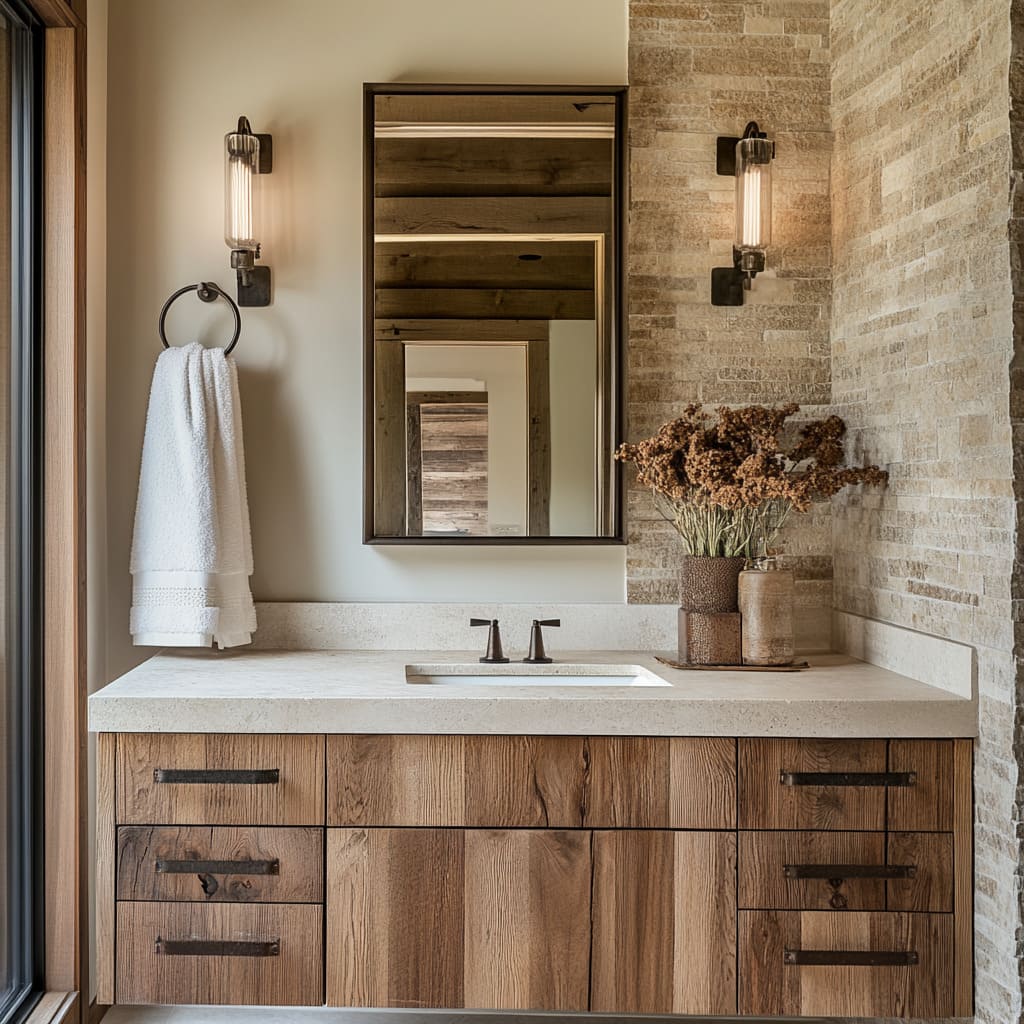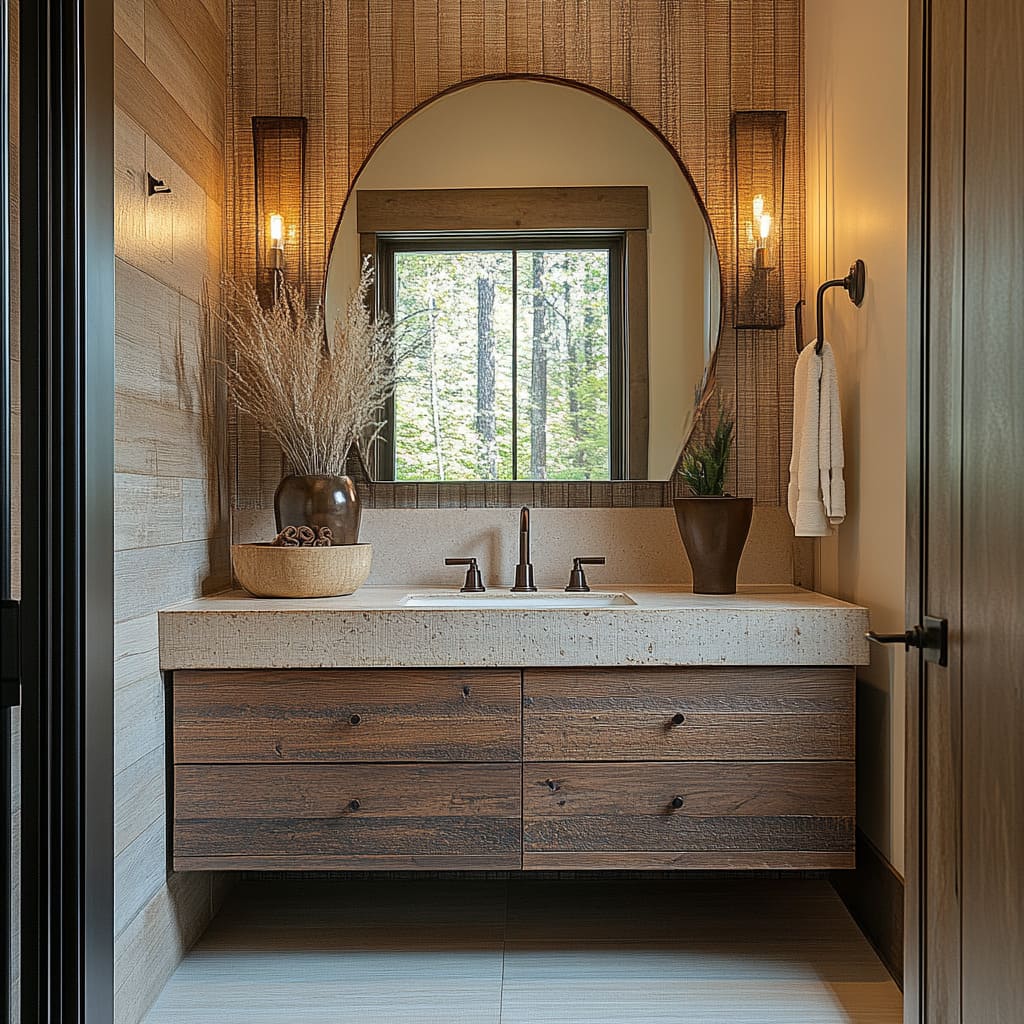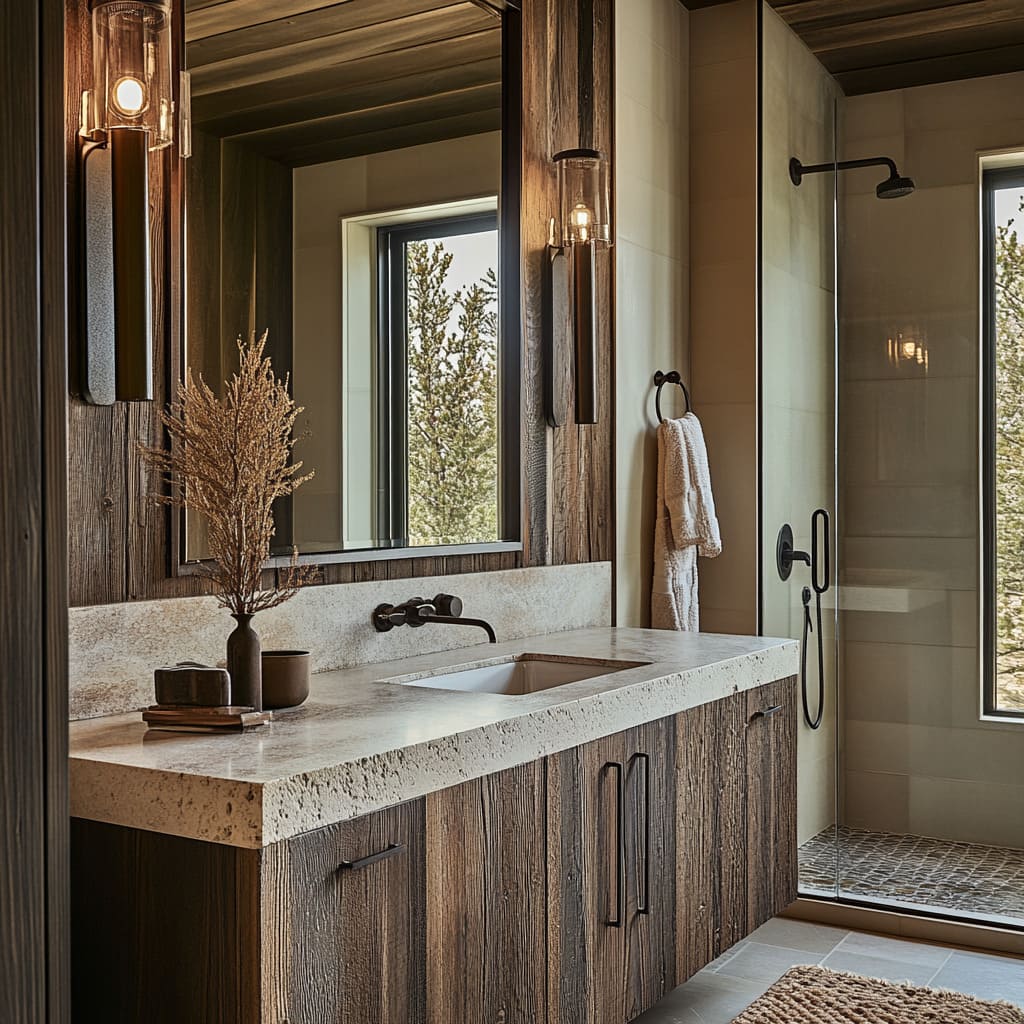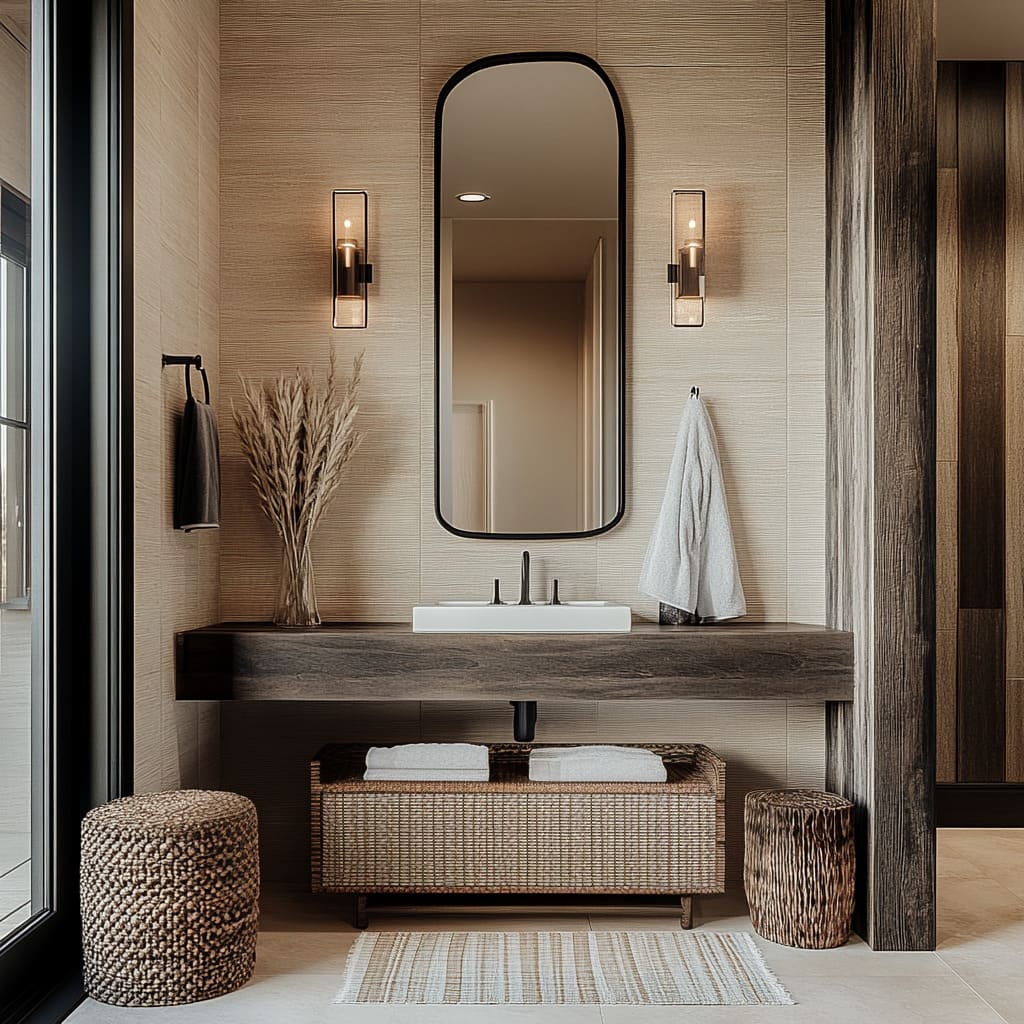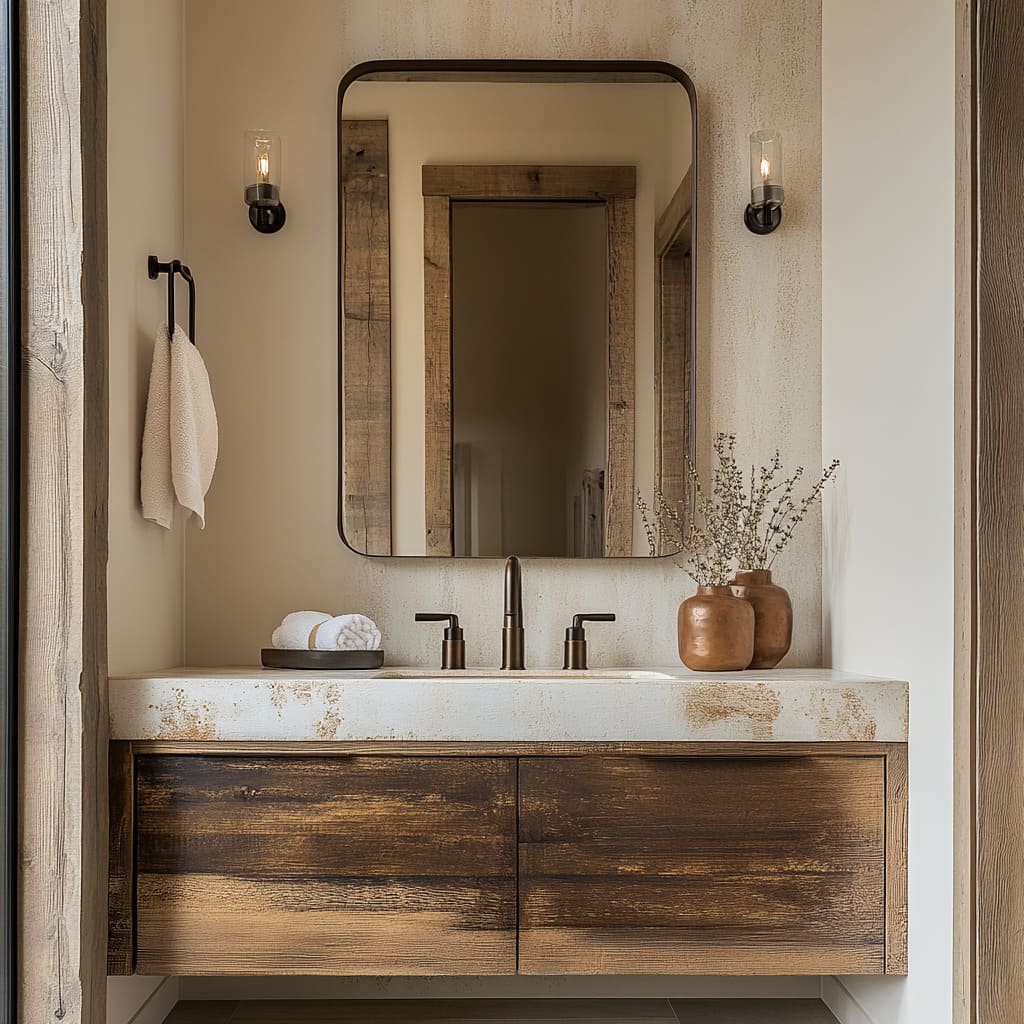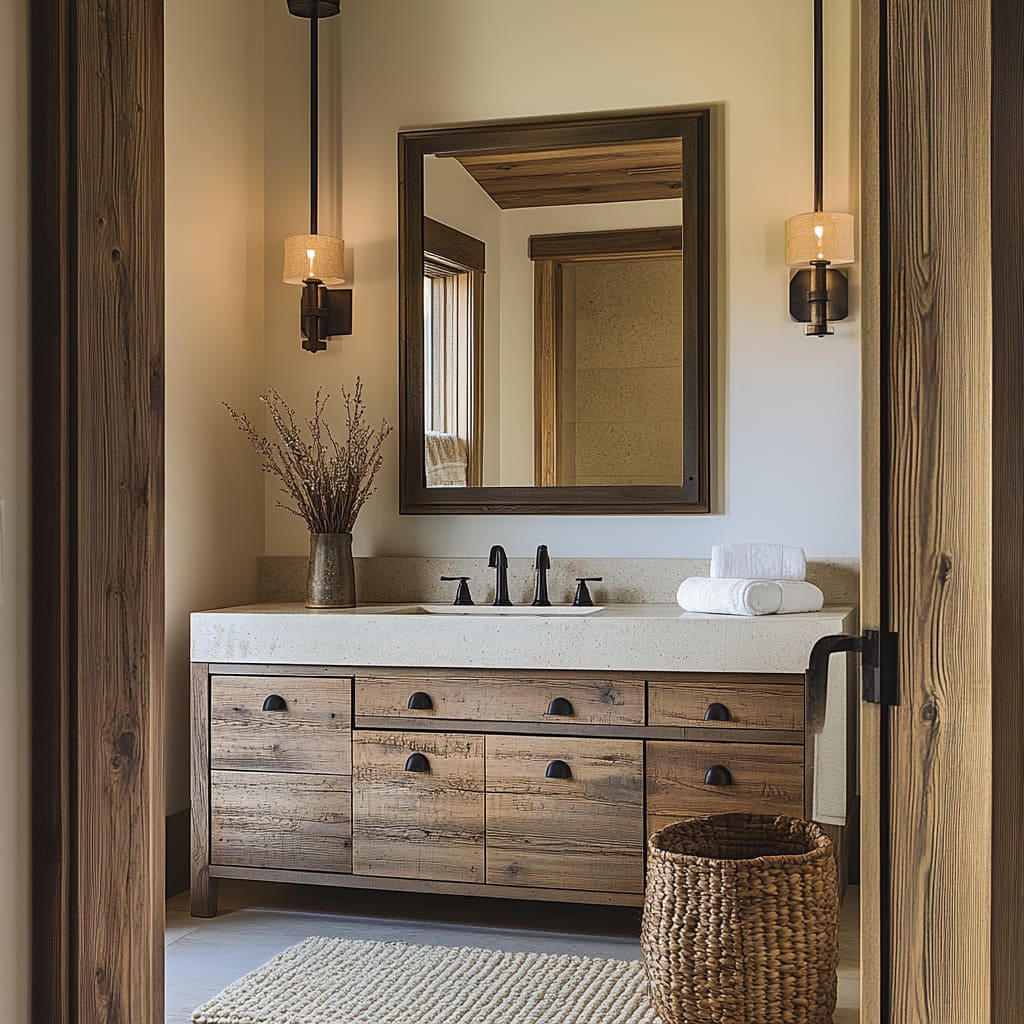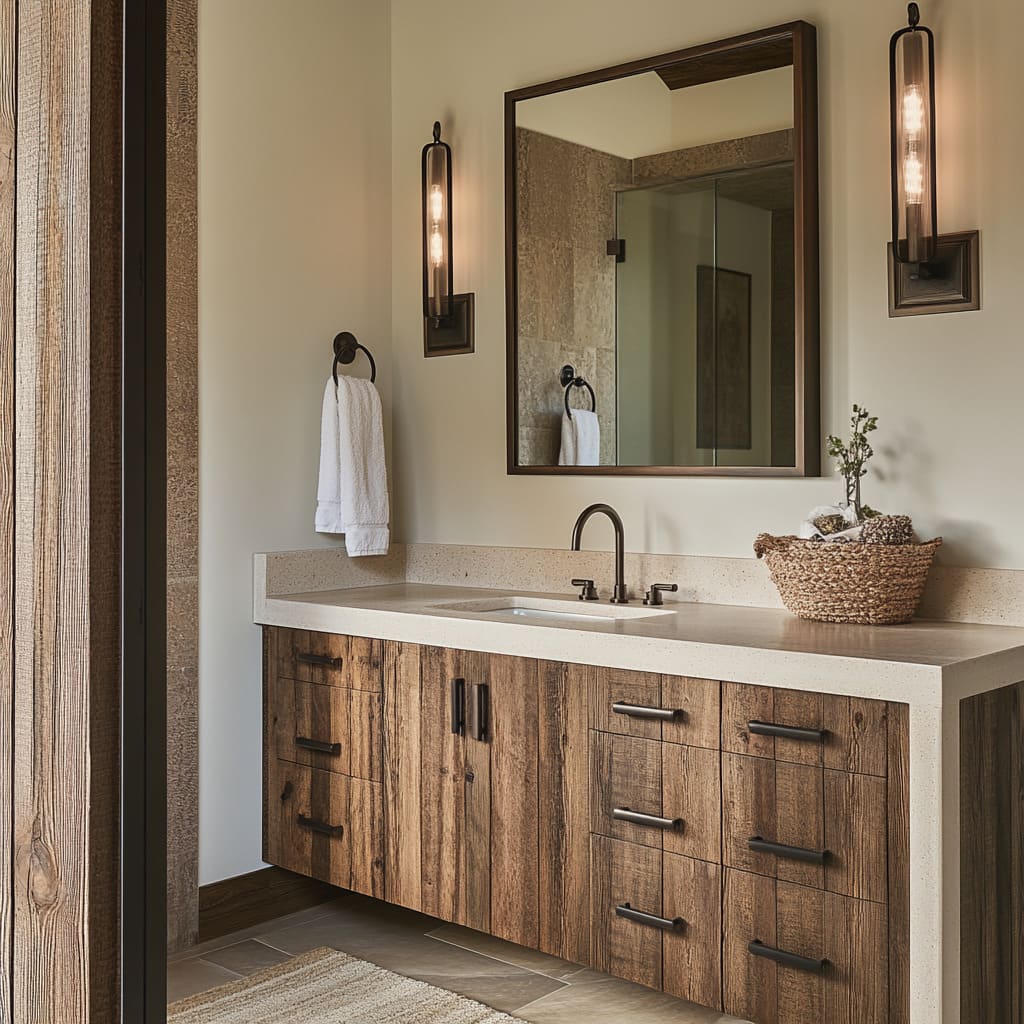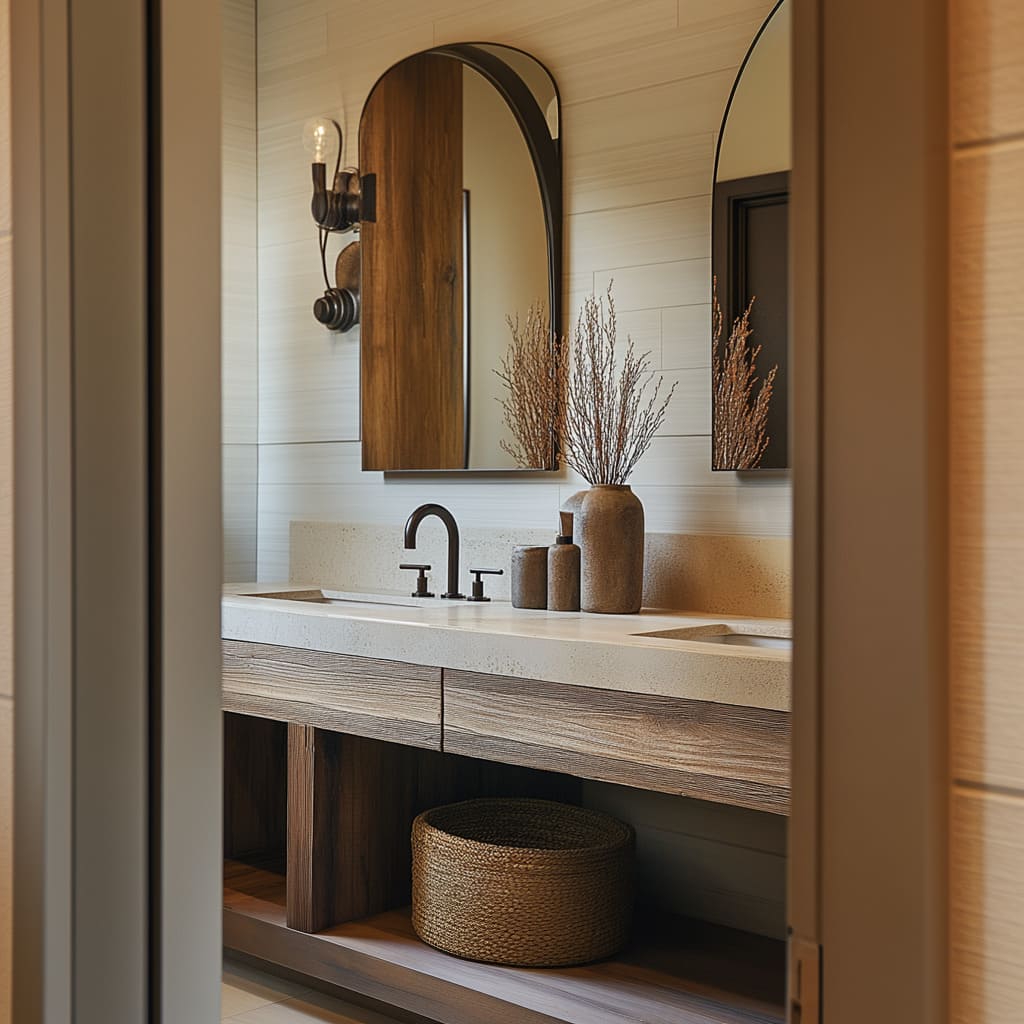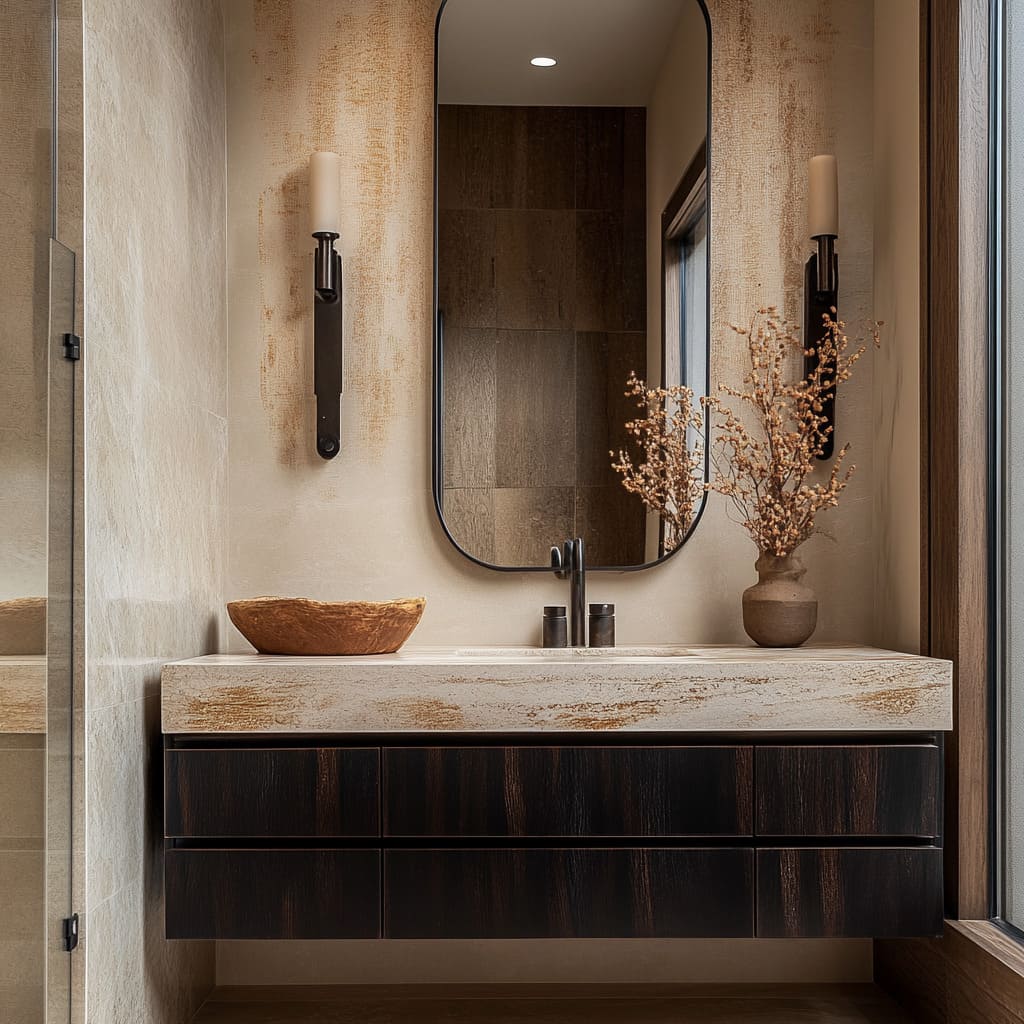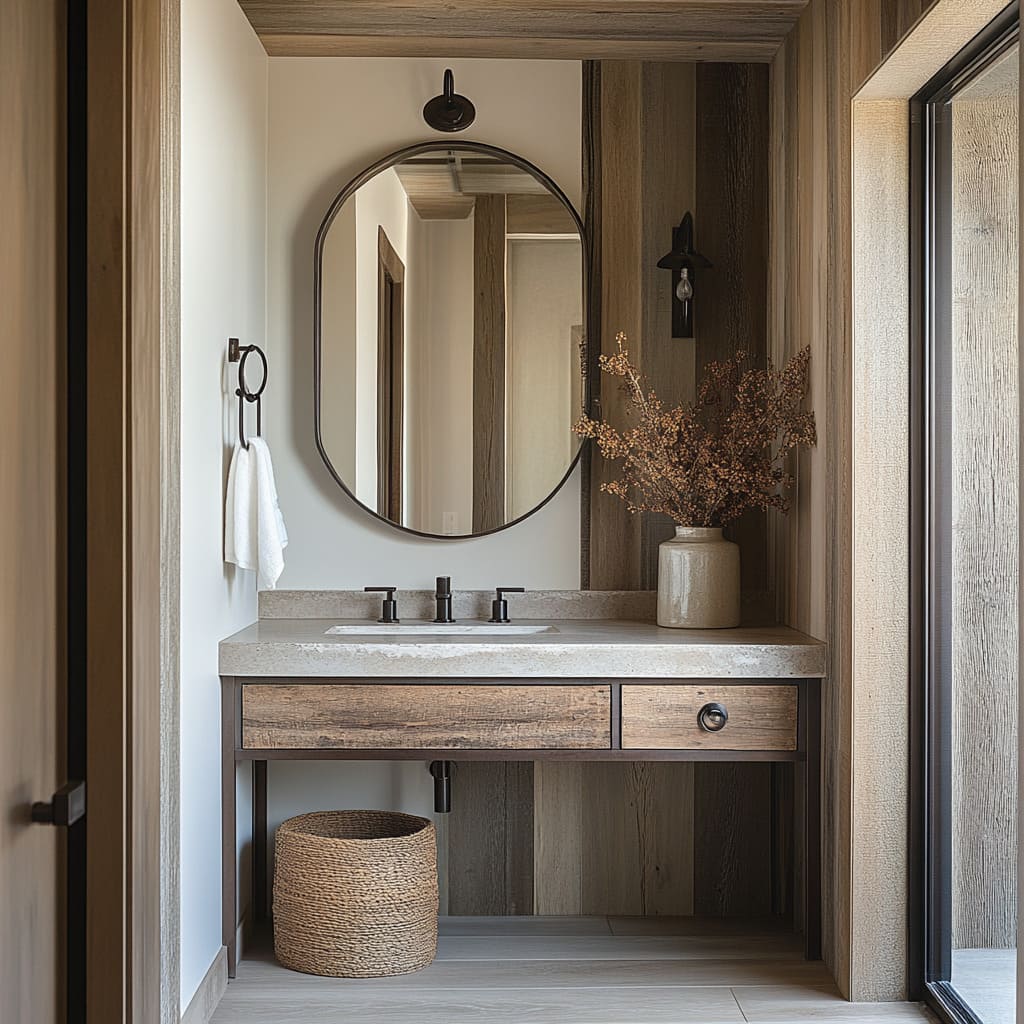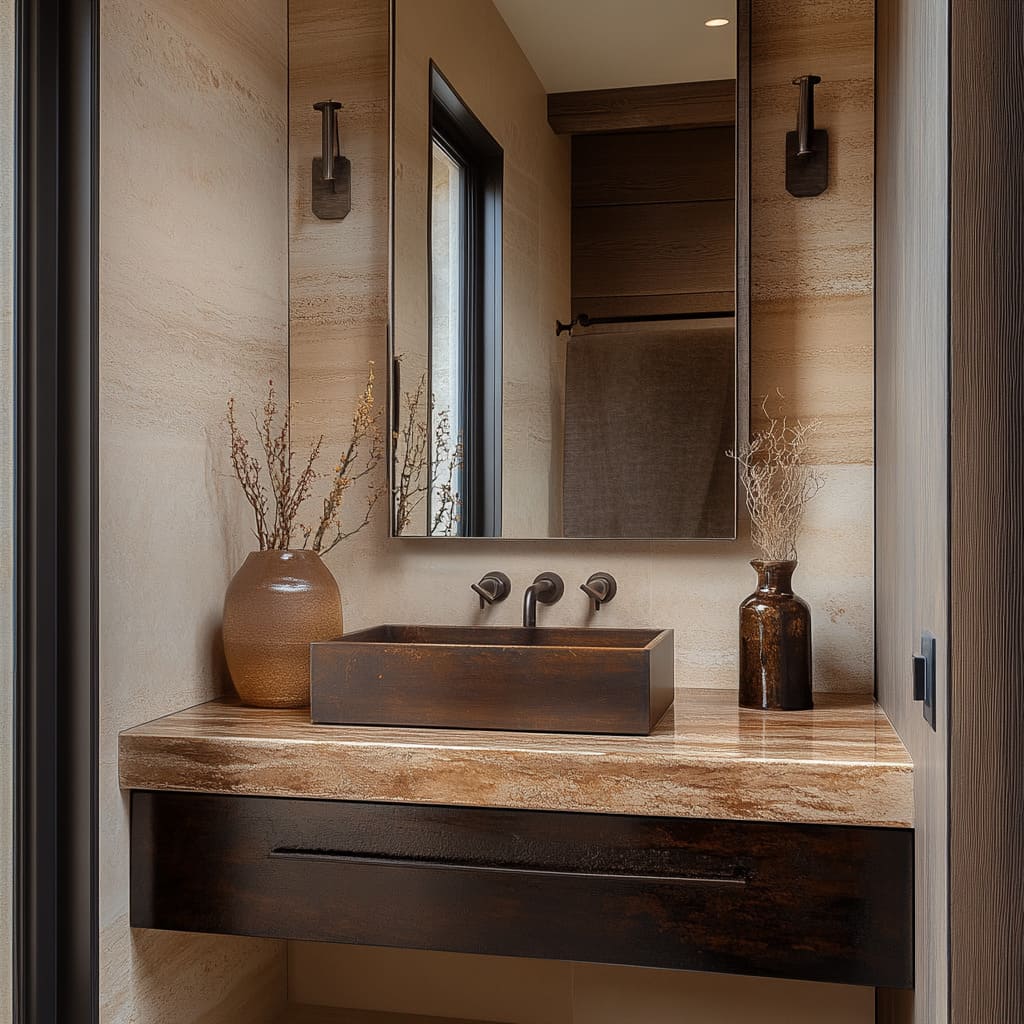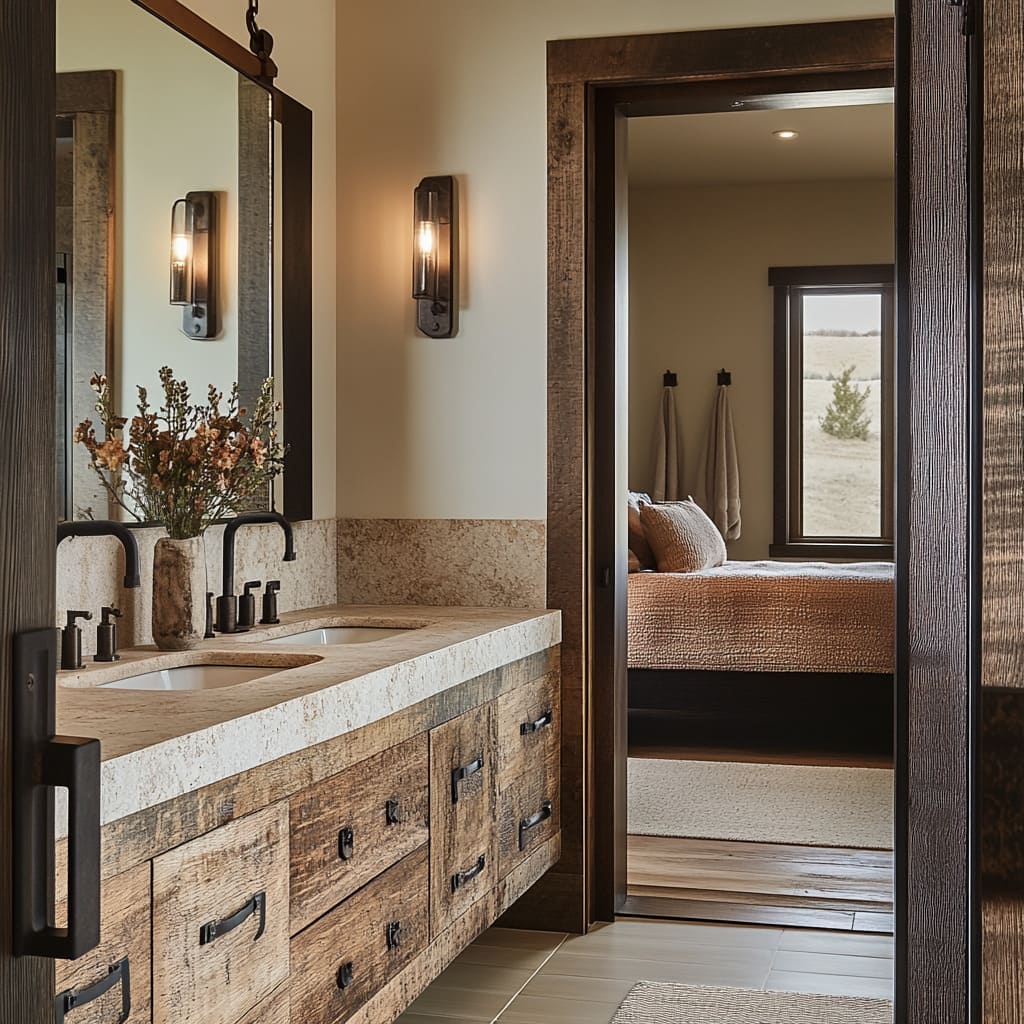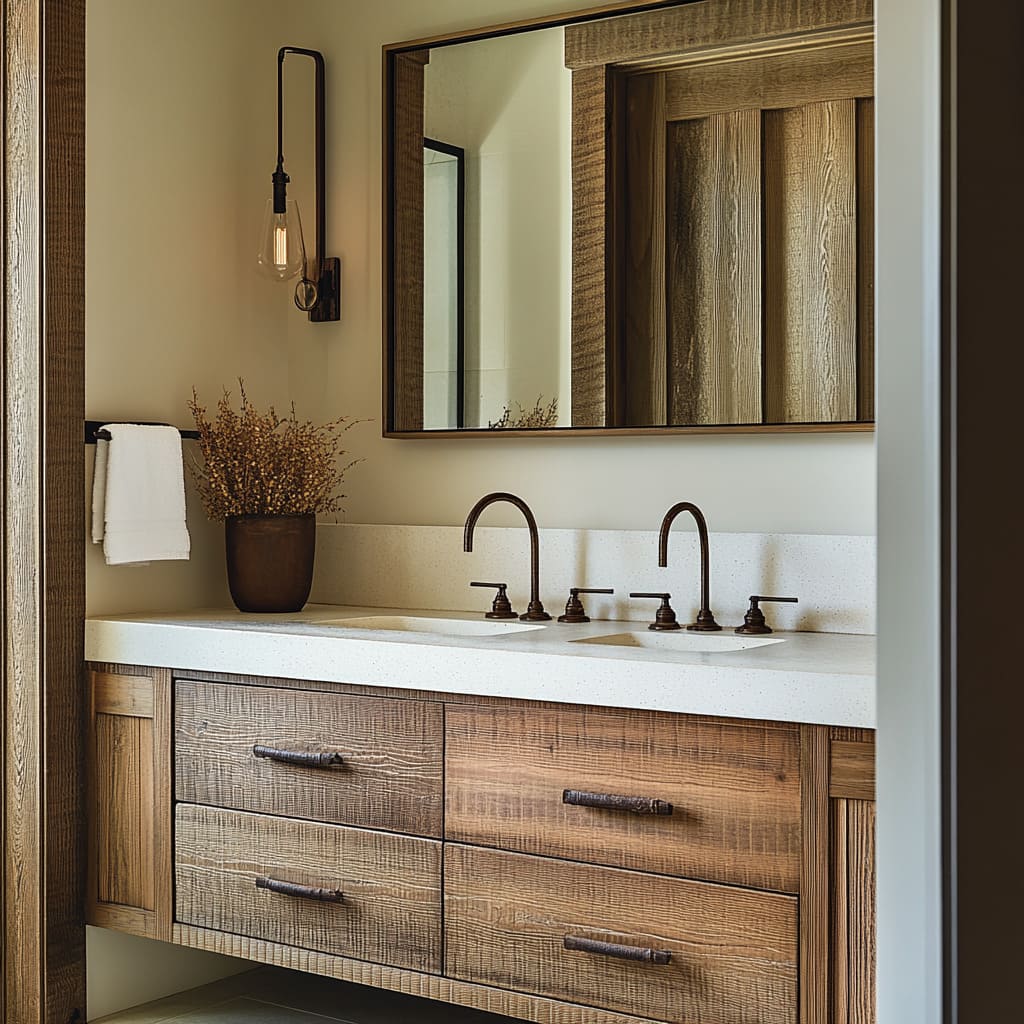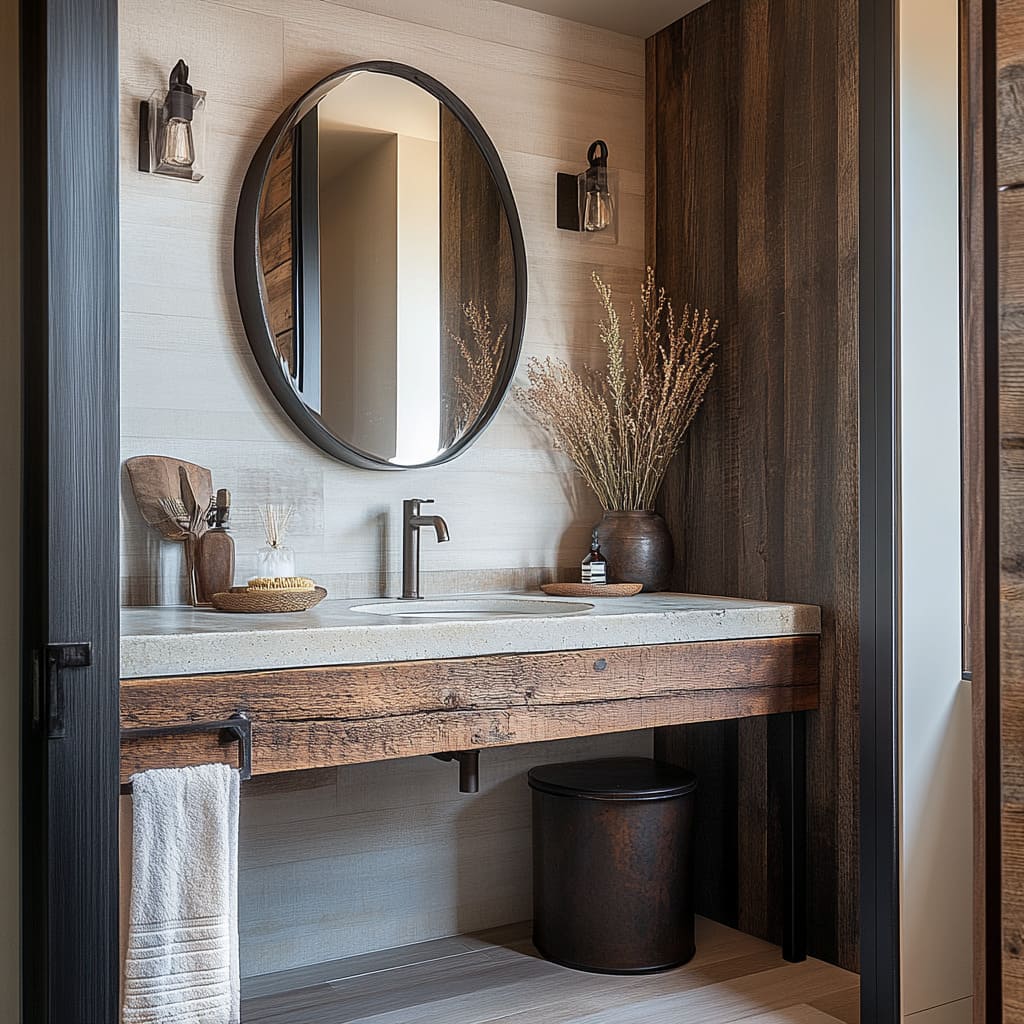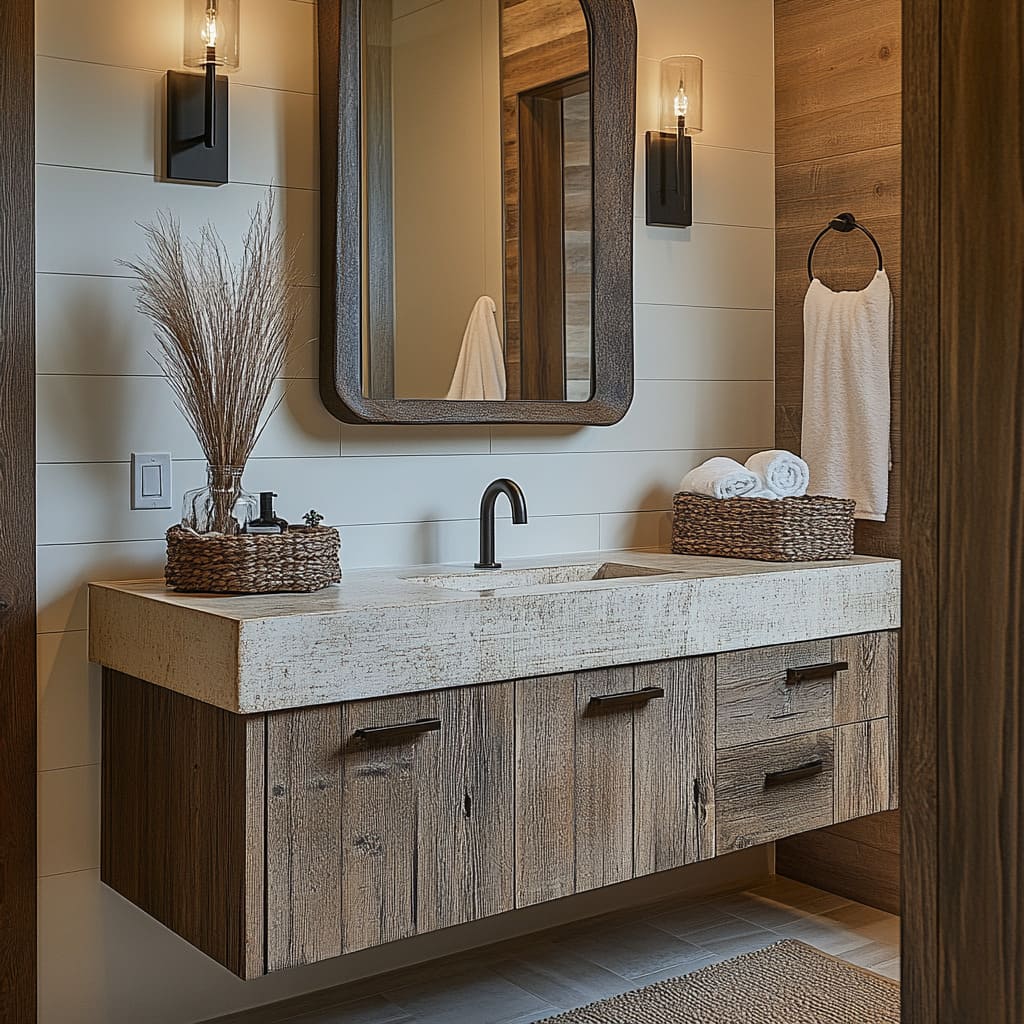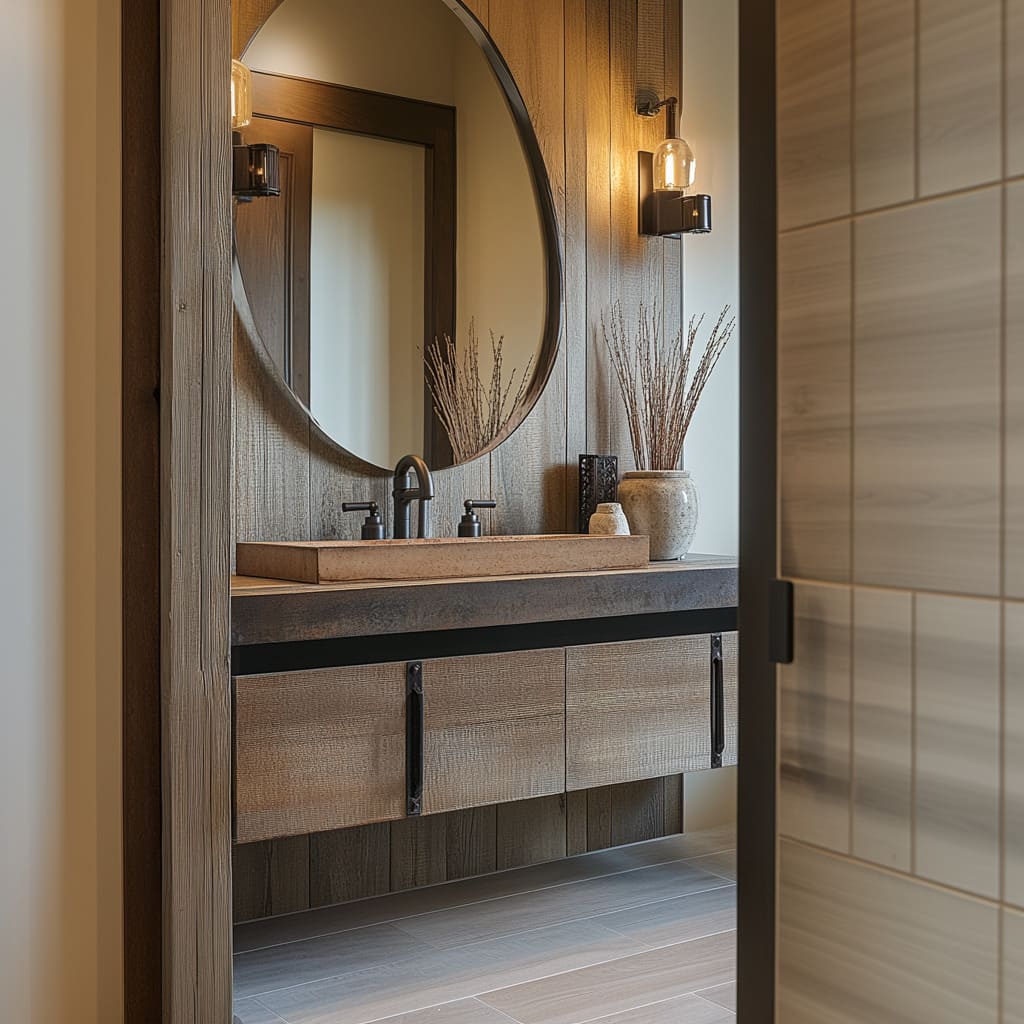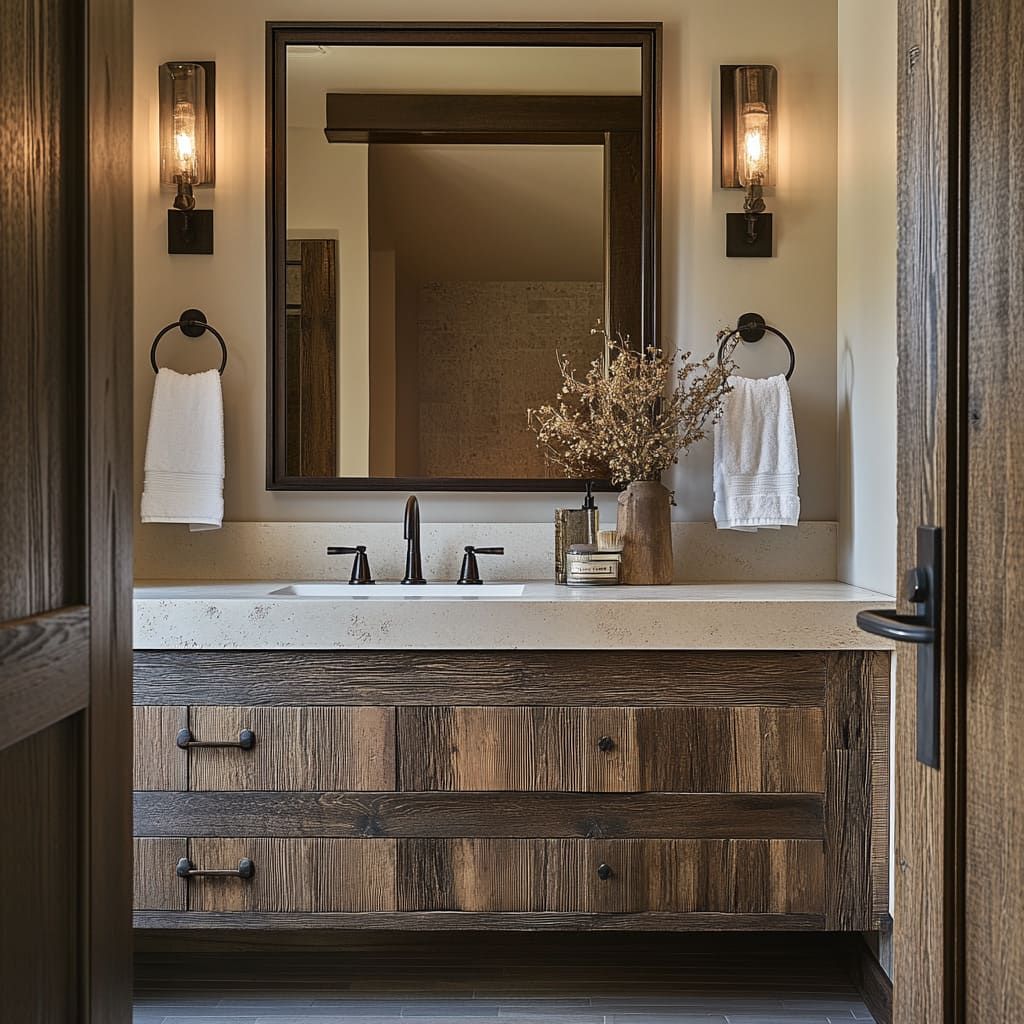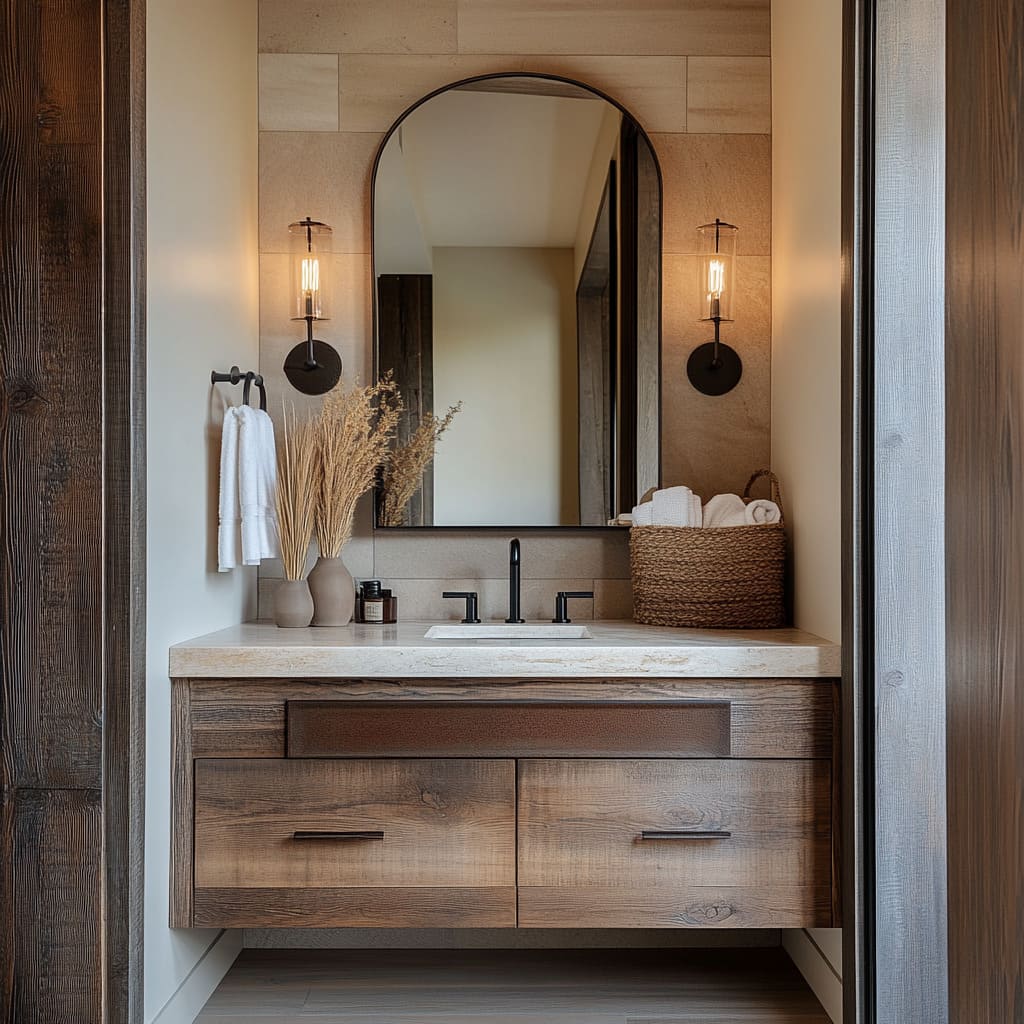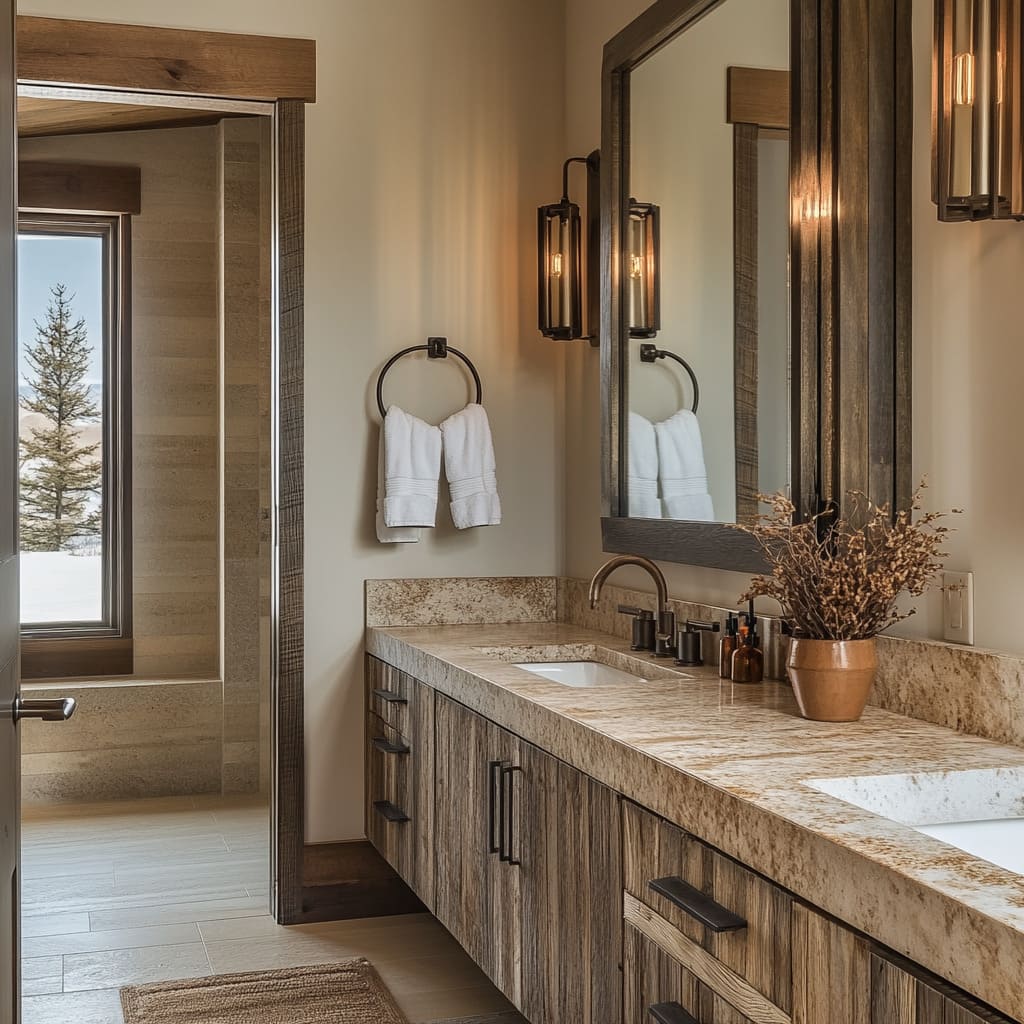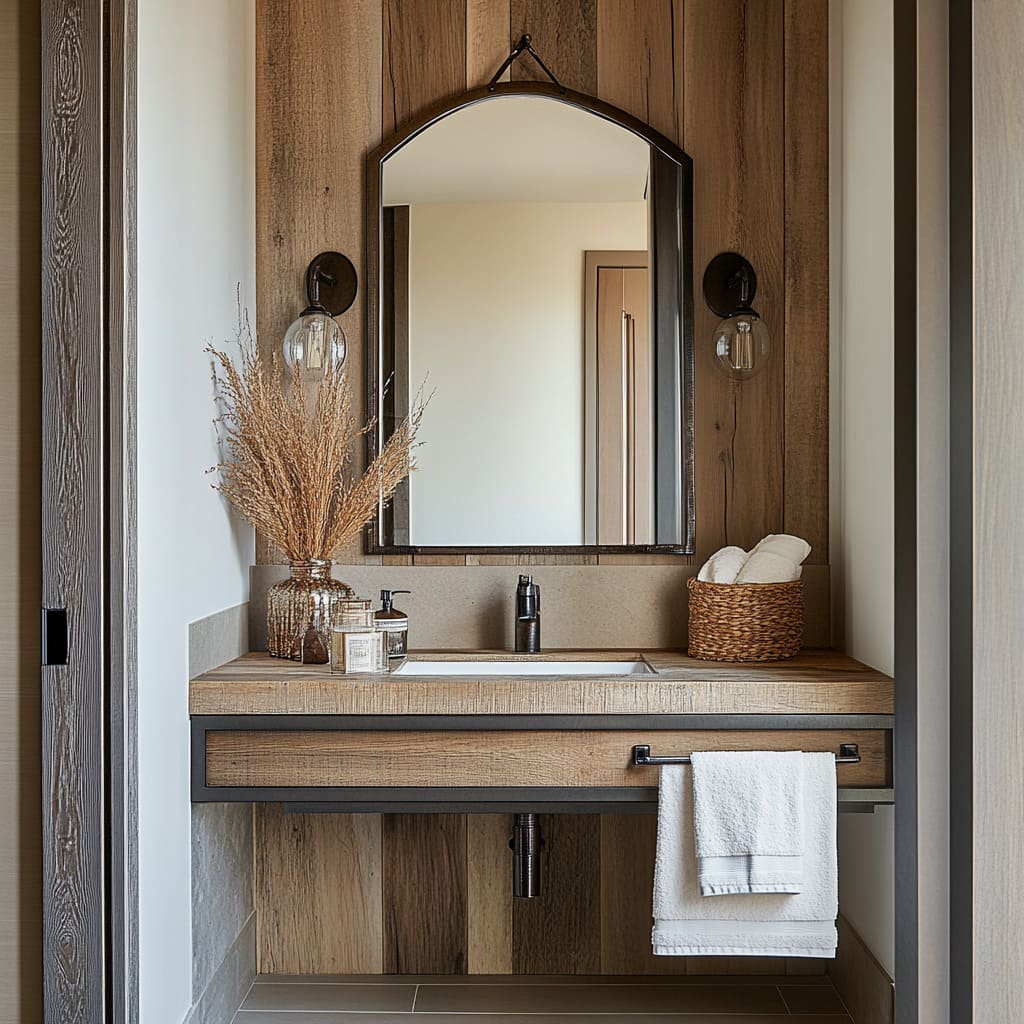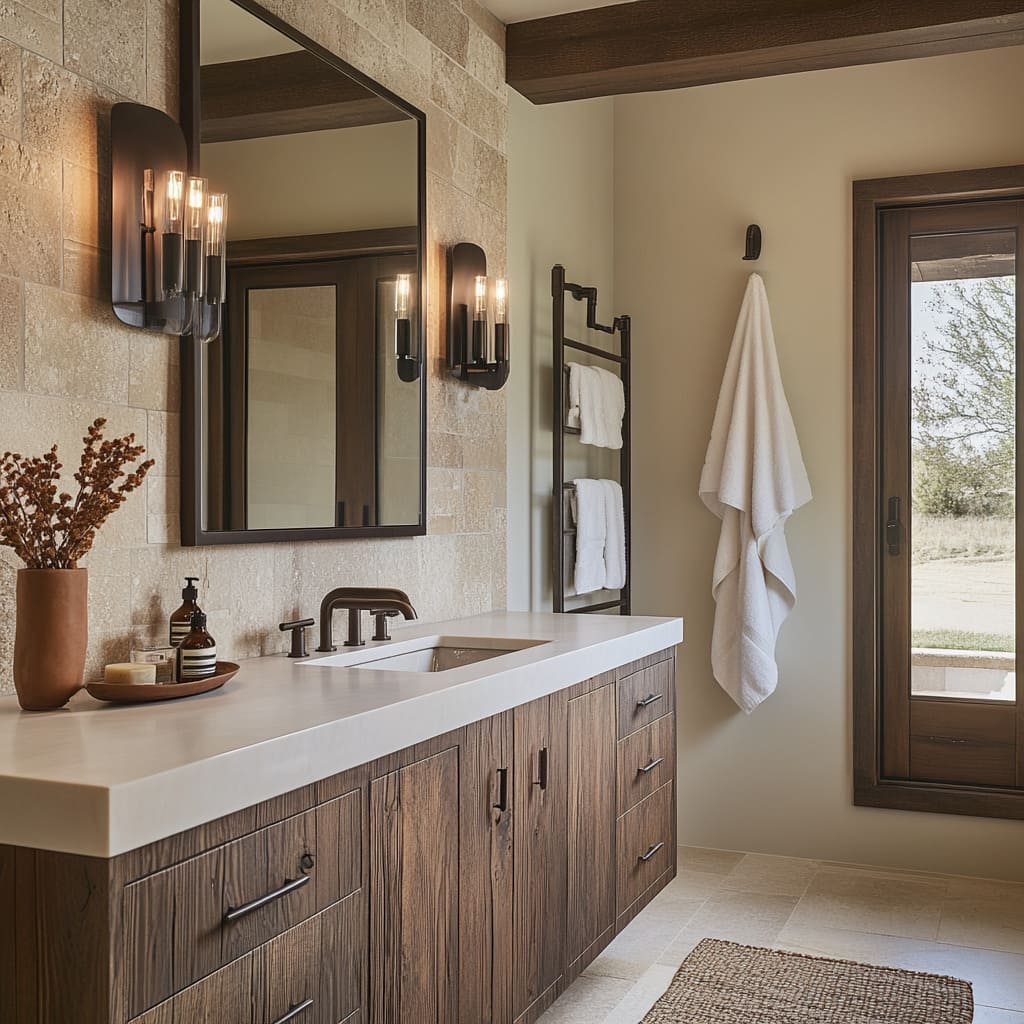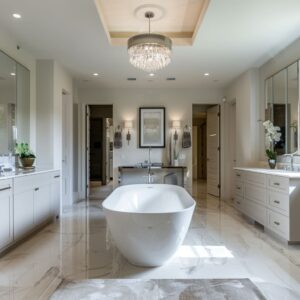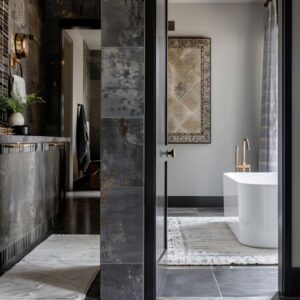In recent years, there has been a noticeable shift in interior design trends towards incorporating more natural materials, and this movement has made its way into the bathroom. Among these materials, wood vanities crafted from reclaimed wooden planks have gained considerable popularity.
These vanities are more than just functional pieces; they serve as striking focal points that combine a sense of warmth with a touch of nature’s charm. This article delves deep into the appeal of using reclaimed wood for bathroom vanities, examining the design elements, complementary materials, and accessories that enhance these unique pieces.
We will explore how these vanities can seamlessly fit into various bathroom styles, offer practical tips for maintenance, and provide insights on why choosing reclaimed wood is a sustainable and aesthetically pleasing option
The Appeal of Reclaimed Wood in Bathroom Vanities
What is Reclaimed Wood?
Reclaimed wood refers to wood that has been repurposed from older structures such as barns, factories, warehouses, or even old homes. This type of wood carries with it a history, often seen in its unique grain patterns, knots, and occasional imperfections.
These characteristics provide a rustic charm that is hard to replicate with new wood. Reclaimed wood is also highly regarded for its durability and strength, having been exposed to the elements over the years, which makes it more stable and resistant to wear.
Using reclaimed wood is not only a nod to sustainability but also a way to bring a piece of the past into a modern home. The aesthetic appeal of this material lies in its rich textures and the unique story each piece tells, making it an ideal choice for a bathroom vanity that stands out
Why Choose Reclaimed Wood for Bathroom Vanities?
Choosing reclaimed wood for bathroom vanities offers several advantages beyond its visual appeal. One of the primary reasons homeowners and designers are drawn to this material is its durability.
Because reclaimed wood has been weathered over time, it tends to be denser and more robust than new wood, making it an excellent choice for high-moisture areas like bathrooms. Additionally, the natural aging process has already allowed the wood to settle, reducing the risk of warping or cracking.
The aesthetic qualities of reclaimed wood—its warmth, texture, and natural imperfections—add a layer of depth and character to a bathroom. The organic feel of the wood can make a bathroom feel more like a retreat, a place of comfort and tranquility.
Moreover, using reclaimed wood aligns with eco-conscious values, as it reduces the demand for newly harvested timber and promotes recycling and reuse, making it an environmentally responsible choice
Design Elements of Reclaimed Wood Vanities
Variety in Design and Finish
Reclaimed wood vanities come in a wide range of designs, each offering its unique flair. From sleek, minimalist styles that float against the wall to more traditional, solid-base designs with ornate detailing, there is a reclaimed wood vanity to suit every taste.
The variety of finishes available further enhances the versatility of these pieces. Some vanities maintain the raw, unfinished look of the reclaimed wood, showcasing its natural grain and texture.
Others might feature a light stain or a matte finish to protect the wood while highlighting its unique characteristics. There are also options that combine reclaimed wood with other materials, such as metal or glass, to create a more contemporary look.
The choice of finish can significantly influence the overall feel of the vanity, from rustic and rugged to sleek and polished.
Customization and Functional Features
Beyond aesthetics, reclaimed wood vanities offer a high degree of customization to meet specific needs and preferences. They are often designed with a variety of drawer and cabinet configurations, allowing for ample storage space while maintaining a clean and organized appearance.
Some designs feature soft-close drawers and doors, enhancing the user experience by reducing noise and wear. Concealed pulls or push-to-open mechanisms are also common, providing a seamless look that doesn’t detract from the beauty of the wood.
The floating design of some vanities adds a modern touch and creates an illusion of space, making it ideal for smaller bathrooms. This versatility in design allows reclaimed wood vanities to blend seamlessly into different bathroom styles, whether it be rustic farmhouse, modern minimalist, or industrial chic
Complementary Materials and Fixtures
Pairing Reclaimed Wood with Natural Stone Countertops
To further enhance the natural appeal of reclaimed wood vanities, many designers choose to pair them with countertops made from natural stone. Materials like limestone, marble, and quartz are popular choices, each offering its distinct look and feel.
Limestone provides a soft, muted tone that complements the warm hues of reclaimed wood, while marble offers a more dramatic contrast with its veining and varied color palette. Quartz, known for its durability and resistance to stains, is a practical option that also adds a touch of elegance.
The combination of wood and stone creates a harmonious blend of textures that is both visually pleasing and functional. The cool, smooth surface of the stone contrasts beautifully with the warm, rugged texture of the wood, creating a balanced and cohesive look that enhances the overall aesthetic of the bathroom.
Faucets, Hardware, and Mirrors: A Cohesive Design
The choice of faucets, hardware, and mirrors plays a crucial role in tying together the design of a reclaimed wood vanity. Matte black or oil-rubbed bronze fixtures are popular choices that complement the rustic feel of reclaimed wood while adding a contemporary edge.
The hardware, such as drawer pulls and cabinet handles, can range from simple and understated to bold and ornate, depending on the desired look. Mirrors framed in matching or complementary materials can further enhance the cohesive design.
A large, statement mirror can create a focal point above the vanity, while smaller, more understated mirrors can offer a subtle complement to the overall aesthetic. The key is to select fixtures and accessories that enhance the natural beauty of the wood without overpowering it, creating a balanced and harmonious design
Discover What Your Budget Can Accomplish for a Bathroom Makeover
Curious about what you can achieve within your budget? Whether it’s a simple refresh or a complete remodel for a trendy farmhouse bathroom with natural wood accents, our tool helps you explore the options. [budget_renovation_calculator]
Lighting and Ambiance
The Role of Lighting in Enhancing Wood Vanities
Lighting is an essential element in any bathroom, and it plays a particularly important role in highlighting the natural beauty of reclaimed wood vanities. The right lighting can enhance the wood’s grain and texture, creating a warm and inviting ambiance.
Wall sconces with clear glass shades and Edison bulbs are a popular choice for bathrooms with reclaimed wood vanities, as they provide a warm, diffused light that complements the natural tones of the wood. For a more modern look, consider using industrial-style fixtures with exposed bulbs or metal accents.
The key is to use lighting that enhances the natural beauty of the wood while providing adequate illumination for daily tasks. Layering different types of lighting, such as ambient, task, and accent lighting, can create a balanced and functional lighting scheme that enhances the overall aesthetic of the bathroom
Industrial and Rustic Lighting Options
In addition to traditional wall sconces, there are a variety of other lighting options that can complement a reclaimed wood vanity. Industrial-style fixtures, with their exposed bulbs and metal finishes, add a contemporary edge that contrasts nicely with the rustic charm of reclaimed wood.
Pendant lights, particularly those with metal or glass shades, can provide a focal point and add a touch of elegance to the space. For a more rustic look, consider using lantern-style fixtures or chandeliers with a distressed finish.
These types of lighting fixtures not only provide functional illumination but also add character and charm to the bathroom, enhancing the overall aesthetic.
Accessories and Decor to Complement Reclaimed Wood Vanities
Natural and Organic Decor Elements
To further enhance the natural aesthetic of a reclaimed wood vanity, consider incorporating accessories and decor elements that reflect the same organic, earthy feel. Woven baskets, for example, add a rustic touch while also providing practical storage for towels and other bathroom essentials.
Ceramic vases filled with dried flowers or branches can add height and texture to the vanity area, creating a focal point that draws the eye. These natural elements complement the wood’s texture and color, enhancing the overall design and creating a cohesive look.
Other accessories, such as soap dispensers, toothbrush holders, and tissue boxes, can be chosen in materials that complement the wood, such as stone, glass, or metal, to create a unified aesthetic.
Coordinating Colors and Textures
When designing a bathroom with a reclaimed wood vanity, it is important to consider the overall color palette and textures of the space. Earthy tones, such as browns, beiges, and grays, work well with the warm hues of reclaimed wood, creating a soothing and harmonious color scheme.
Consider incorporating different textures, such as smooth stone, rough wood, and soft textiles, to add depth and interest to the space. This layering of textures creates a visually dynamic environment that is both comfortable and visually appealing.
Additionally, consider using complementary colors and finishes in other elements of the bathroom, such as the flooring, walls, and fixtures, to create a cohesive and well-balanced design
Integrating Reclaimed Wood Vanities into Various Bathroom Styles
Modern Rustic: A Harmonious Blend
Reclaimed wood vanities are particularly well-suited to modern rustic bathroom designs, which combine the clean lines and minimalist aesthetic of modern design with the warmth and character of rustic elements. In this style, the reclaimed wood vanity serves as a focal point, adding a touch of natural beauty to an otherwise sleek and contemporary space.
Pairing the vanity with modern fixtures, such as matte black faucets and industrial-style lighting, creates a balanced look that is both stylish and functional. The key to achieving a successful modern rustic design is to balance the rustic and modern elements, creating a cohesive look that is both comfortable and sophisticated.
Farmhouse and Cottage Styles
Reclaimed wood vanities are a natural fit for farmhouse and cottage-style bathrooms, which emphasize warmth, comfort, and a sense of nostalgia. In these styles, the vanity serves as a central element, adding a touch of rustic charm to the space.
To enhance the farmhouse or cottage aesthetic, consider pairing the vanity with vintage-inspired fixtures, such as oil-rubbed bronze faucets and distressed metal hardware. Decorative elements, such as vintage mirrors, woven baskets, and ceramic accessories, can further enhance the rustic feel of the space, creating a cozy and inviting environment.
Industrial Chic and Transitional Styles
Reclaimed wood vanities can also be integrated into industrial chic and transitional bathroom designs, which blend different styles to create a unique and eclectic look. In an industrial chic bathroom, the vanity can be paired with exposed metal fixtures, concrete elements, and industrial lighting to create a bold and contemporary aesthetic.
In a transitional bathroom, the vanity can be combined with more traditional elements, such as classic fixtures and decorative accessories, to create a look that is both timeless and modern. The versatility of reclaimed wood allows it to fit seamlessly into a variety of design styles, making it a popular choice for homeowners and designers alike.
Are you thinking about upgrading your bathroom but unsure about the cost? Our remodel cost calculator is here to help.
It’s a straightforward way to see what your renovation might approximately cost. Just provide your details, and you’ll receive a detailed cost breakdown to help you plan your bathroom transformation with confidence!
Practical Considerations for Choosing Reclaimed Wood Vanities
Maintenance and Care Tips
While reclaimed wood vanities offer many aesthetic and functional benefits, they also require proper care and maintenance to ensure their longevity. Because wood is a natural material, it is susceptible to moisture and humidity, which can cause warping or cracking over time.
To protect your vanity, it is important to apply a protective sealant or finish that is designed to withstand the humid environment of a bathroom. Regular cleaning with a mild, non-abrasive cleaner is also recommended to prevent dirt and grime from building up on the surface.
In addition, it is important to wipe up any spills or splashes immediately to prevent water damage. By following these simple care tips, you can ensure that your reclaimed wood vanity remains beautiful and functional for years to come
Installation Tips and Considerations
When installing a reclaimed wood vanity, there are several key considerations to keep in mind to ensure a successful installation. Because reclaimed wood is often heavier than new wood, it is important to ensure that the wall and plumbing are adequately reinforced to support the weight of the vanity.
In addition, the floating design of many reclaimed wood vanities requires precise measurements and professional installation to ensure a secure fit. It is also important to consider the placement of the vanity in relation to other elements in the bathroom, such as the sink, toilet, and shower, to ensure proper flow and functionality.
By taking these factors into account, you can ensure that your reclaimed wood vanity is installed correctly and securely, providing a beautiful and functional addition to your bathroom
Conclusion
Reclaimed wood vanities offer a unique and stylish way to incorporate natural materials into your bathroom design. Their warm tones, unique grain patterns, and rustic charm create a focal point that enhances the overall aesthetic of the space.
By pairing these vanities with complementary materials, such as natural stone countertops and matte black fixtures, you can create a cohesive and well-balanced design that is both functional and visually appealing. Whether you are looking to create a modern rustic retreat, a cozy farmhouse bathroom, or an industrial chic oasis, reclaimed wood vanities offer the perfect blend of style and functionality.
With proper care and installation, these vanities can provide a beautiful and sustainable addition to your home for years to come

